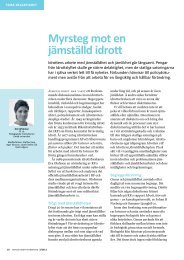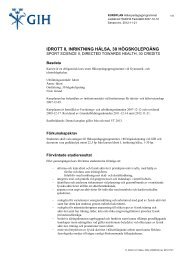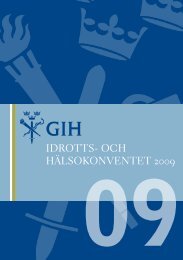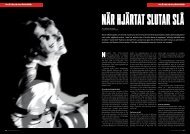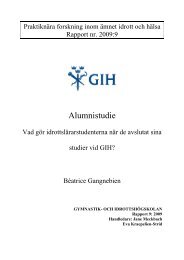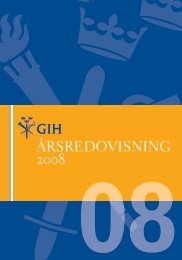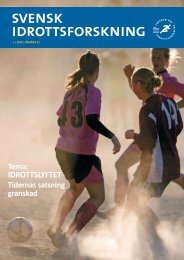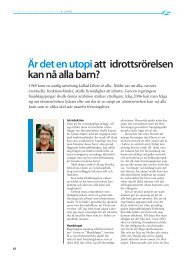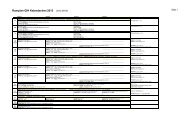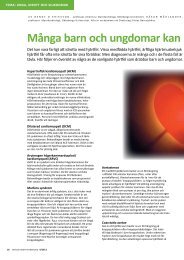Programme and abstracts - GIH
Programme and abstracts - GIH
Programme and abstracts - GIH
You also want an ePaper? Increase the reach of your titles
YUMPU automatically turns print PDFs into web optimized ePapers that Google loves.
Abstract:Since the settlement/invasion of Europeans on the Australian continent the majority of thehuman population has been urban, predominately in the wetter southern <strong>and</strong> eastern areas.The continent is home to both high biodiversity <strong>and</strong> endemic species. Australia has thedubious record of the worst rate of mammal extinction in recent times, <strong>and</strong> many otheranimals <strong>and</strong> plants are also at risk of extinction. Because of the continent’s physical isolation<strong>and</strong> colonial history the notions of native <strong>and</strong> introduced flora <strong>and</strong> fauna are pronounced <strong>and</strong>important to underst<strong>and</strong>ing the long-term survival of many species. From an educationperspective, although the urban <strong>and</strong> rural areas offer different experiences, one cannotassume that those from urban areas lack access to the natural world, or that rural dwellershave greater opportunities. Endangered fauna may be found living in urban areas, <strong>and</strong> manyrural areas have little or no remaining flora <strong>and</strong> fauna. In this paper I will consider outdoorenvironmental education in an Australian context <strong>and</strong> the dynamic between urban <strong>and</strong> ruralexperiences <strong>and</strong> knowledge of the l<strong>and</strong>. I will employ the Deleuzo-Guattarian concept ofassemblage to re/consider education socio-ecological imperatives <strong>and</strong> opportunities with/inurban-rural interface.Title:Using urban nature for outdoor training <strong>and</strong> experiential learning purposes.Author/s:Susanne Lesk, Vienna University of Economics <strong>and</strong> Business, Austria.Abstract:In Austria, there are different traditions concerning the outdoor work with young people oradults. Some approaches use outdoor training as an end in itself, others assume that there isan automatic effect produced by experiences in (urban) nature. In the presented projects theAustrian concept of IOA® (Integrative Outdoor Aktivitäten), is applied, which emphasizes theuse of outdoor methods in combination with previously fixed objectives <strong>and</strong> topics. Thispresentation aims to illustrate how urban nature (e.g. parks, the Danube isl<strong>and</strong>, the naturalenvironment including small forests, meadows <strong>and</strong> hills), all being part geographically of thecity of Vienna, can be used for different target groups <strong>and</strong> settings in the context of outdoortraining <strong>and</strong> experiential learning situations (e.g. in the field of secondary <strong>and</strong> tertiaryeducation or vocational training). Placing the focus on urban nature raises questionsconcerning the theoretical <strong>and</strong> practical relationship between culture <strong>and</strong> nature. Urban nature<strong>and</strong> different places within it can be experienced <strong>and</strong> perceived differently than naturalsurroundings outside the city. We have more observers, more noise <strong>and</strong> other externalinterferences than outside the cities, but the urban nature in places like Vienna offers alsosome additional options.Title:Becoming Outdoor: The implications for working with young people.Author/s:Diane Collins, Journeying Gently, UK.Abstract:Throughout my career in teaching, youth work <strong>and</strong> community development work, I have beenfascinated by why it is that some people engage with the outdoors, while the focus for othersis indoor activities. What impact might this have on environmental underst<strong>and</strong>ing <strong>and</strong> action?Drawing on the findings of research undertaken with people in the non-formal sectors ofeducation, I will explore why it is that some of us define ourselves as ‘outdoor’, whereas otherssee themselves as indoor people. Some of the factors related to gender, socio-economic <strong>and</strong>socio-cultural backgrounds, ethnicity <strong>and</strong> disability, <strong>and</strong> personal attitudes to the outdoors, willbe identified. Finally, I will reflect on how outdoor practitioners might replicate some of theexperiences that have contributed to us <strong>and</strong> others becoming outdoor people, so that we can34




